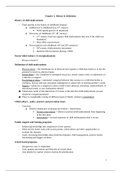Chapter 1: History & definitions
History of child maltreatment
- Three periods in the history of childhood (Empey)
o Indifference to childhood (pre-15th century)
Wide-spread practice of infanticide
o Discovery of childhood (15th-18th century)
17th century: first laws against child maltreatment (but only if the child was
blameless)
Mary Ellen case (lecture)
o Preoccupation with childhood (19th and 20th centuries)
19th century child protective movement
Battered child syndrome (Kempe, 1960)
Parent-child violence: 4 conceptualizations
- Picture in book!!!
Definitions of child maltreatment
- Physical abuse = the intentional use of physical force against a child that results in, or has the
potential to result in, physical injury
- Sexual abuse = any completed or attempted sexual act, sexual contact with, or exploitation of
a child by a caregiver
- Psychological abuse = intentional caregiver behavior that conveys to a child that he/she is
worthless, flawed, unloved, unwanted, endangered or valued only in meeting another’s needs
- Neglect = failure by a caregiver to meet a child’s basic physical, emotional, medical/dental, or
educational needs, or any combination thereof.
Unfortunate result of this distinction of 4 forms is the idea that child maltreatment can and
should be compartmentalized
There is considerable overlap of different types of family violence (comorbidity)
Child welfare – policy, practice and prevention issues
- Concerns:
o Relative importance of primary prevention > intervention
Primary intervention = efforts to prevent child maltreatment from happening
in the first place
Intervention = societal responses to child maltreatment after it occurs
Family support and training programs
- Enhancing knowledge and competence of new parents
- Often involve home visits with at-risk parents, which allows providers opportunities to
evaluate the situation
- Goals: increasing knowledge about child development, child management, positive family
functioning and triggers of abuse
School-based programs
- Inexpensive, easy to implement
- Goal: primary prevention and detection of sexual abuse
- Also helpful for marital violence duction & identification
1
,Community awareness campaigns
- Easiest, most cost-effective
- Public education through advertisements and public service announcements
- Anger management & identification
Justice and protection
- Deterrence model: best way to prevent child maltreatment is to commit resources to polie and
CPS efforts to identify and apprehend offenders and impose harsher penalties for those
convicted of child maltreatment
o Specific deterrent: when an offender is caught and punished, they are less likely to
commit the act again
o General deterrent: a society that harshly punishes child offenders should produce
fewer child offenders
- Community notification laws:
o Megan’s law: all states are required to track the whereabouts of sex offenders and
make that information available to the public
Chapter 2: Study of child maltreatment
Introduction
- Different disciplines have different perspectives, which leads to difficulty
- Challenging to study & difficult to explain
Determining extent of child maltreatment
- Actual numbers are difficult to estimate – illustrated using funnel
I. Actual cases of child maltreatment
II. All child maltreatment that comes to attention of professionals
III. Referrals that are reported to hotline or intake workers at CPS (Child Protective
Services)
IV. Cases screened-in: in which intake workers determine that the report is legitimate and
likely satisfies legal definitions of child maltreatment (60% of III.)
V. Substantiated cases: child protection agencies have determined that the abuse
occurred
VI. Cases in which the state intervenes (said to be even 60% of V.)
Can be turned over to criminal justice system (VI & VII) – this shifts the focus away from the
child (the victim) to the offender.
Dark figure: gap between crime that is actually committed and crime that is reported (dark
because we cannot know how large it is – but it is very large in child maltreatment)
2
, Official statistics: from the Federal Bureau of Investigation, CPS or other professionals –
amount of child maltreatment that comes to attention of those mandated to protect children
(includes level VI, III, II)
Self-report surveys: surveys of general public concerning violence in family (only way to
estimate level I)
Official estimates
- Two primary sources:
o National Child Abuse and Neglect Data System (NCANDS)
Most important data source in US (per state)
Problems:
Only on child maltreatment reported to CPS
Definitions of abuse, investigative prceses and data collection are
determined at state level what is or isn’t abuse will differ per state
o National Incidence Study (NIS)
Widely respected
Uniform definitions of abuse (standardized)
Relatively broad definition of abuse, which includes harm standard
& endangerment standard (allows researchers to include children
who haven’t been harmed but are in danger of being harmed)
Self-report surveys
- Two types of self-report surveys
o Self-report perpetration surveys: ask respondants about their own abusive &
neglectful behavior
o Self-report victimization surveys: asks about experiences as victims of child
maltreatment
Parent-Child Conflict Tactics Scales uses both types (both own behavior and past)
Advantages:
o Provide information about what is not reported
Problems:
o Retrospective nature: can you recover repressed memories?
o Respondents might not be truthful/ have a different idea of ‘abuse’
- Conflict tactics scales (CTS):
o Most widely used scales in self-reported family violence research
o Measures various tactics & behaviors that parents might use when upset with their
child
o Problems:
Internal consistency is low, because parents who engage in one form of
maltreatment do not necessarily engage in others
Parents may not be honest (tried to control for this, but still a problem)
- National Crime Victimization Survey (NCVS): not very useful in measuring child
maltreatment
- Juvenile Victimization Questionnaire (JVQ): measures exposure to wide variety of childhood
victimization
Explaining child maltreatment
Cultural and structural antecedents
3





